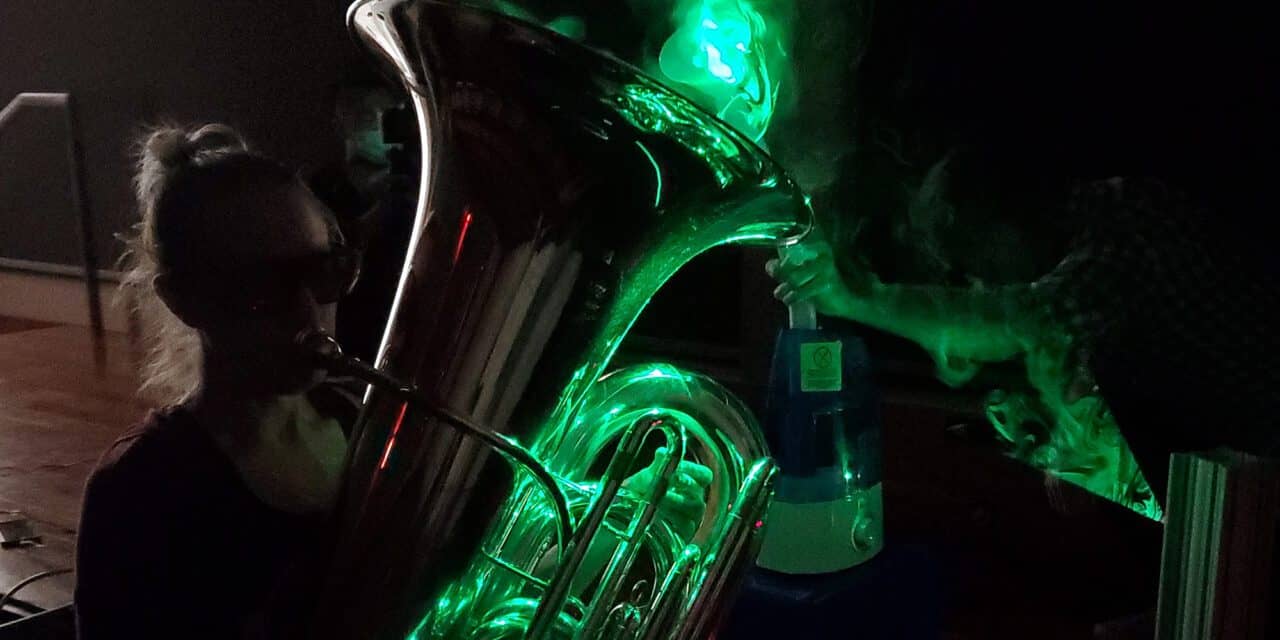By Katherine Unger Baillie, Senior Science News Officer, University of Pennsylvania
The latest research from the labs of Penn scientists Paulo Arratia and Douglas Jerolmack was an answer to “a call for help,” says Arratia. It was 2020, and the Philadelphia Orchestra, like so many cultural institutions, had suspended performances due to the COVID-19 pandemic. Through PJ Brennan, chief medical officer of the University of Pennsylvania Health System, the Orchestra sought expertise to help understand whether its musicians could return to playing in a safe physical arrangement that would minimize the chances of exposing one another, or their audiences, via aerosols, to SARS-CoV-2.
Related article: Making Musical Performance Safer During COVID-19
An article detailing the research appears on Penn Today, the University of Pennsylvania’s news website.
“The Orchestra director didn’t want the musicians to be far apart; they needed to be close together to produce the best sound,” said Arratia, of the School of Engineering and Applied Science. “And yet, if they needed to be separated with plexiglass, that also posed a problem.” The musicians reported problems hearing one another and poor sightlines with plexiglass dividers. “The challenge was, how can we get away from this to the point where they can play unobstructed but still safely,” Arratia said.
Now, in a publication in Physics of Fluids, Arratia, Jerolmack, and colleagues report on their findings, which suggest the aerosols musicians produce dissipate within about six feet. The results not only informed the arrangement of the Philadelphia Orchestra as they resumed performances in the summer of 2020 but also laid the groundwork for how other musical groups might think about safely gathering and playing.
“Having experts like Paulo and Doug, who could measure particle size, and trajectory, and distance, and velocity, were really valuable in making decisions for the orchestra,” said Brennan, who now serves on the Orchestra’s Board of Directors. “Those decisions included the spacing between players, the distancing between sections, who needed to mask. As they gathered this information, along with the testing and case tracking that Penn Medicine was doing, it helped us make decisions with confidence.”
Experimental approach
The research hinged on the questions of how many aerosol particles the musicians generated, how densely the particles were emitted from the instruments, and how fast they traveled through the air.
“You can have a big jet of air coming out, but if the aerosol concentration is very low it doesn’t much matter,” said Jerolmack, of the School of Arts & Sciences and Penn Engineering. “Or you can have a lot of aerosols that get concentrated in a narrow beam. Those things are important to understand.”
To gather data, the researchers invited Orchestra musicians to campus, bringing along their wind instruments, including flutes, tubas, clarinets, trumpets, oboes, and bassoons.
In order to visualize and track the aerosols flowing out of the instruments as the musicians played, the researchers operated a humidifier that emitted water vapor droplets at the bell end of the instruments. This arrangement was only shifted for the flute player, for whom the humidifier was placed near the musician’s mouth instead of the bell, since air travels over the mouthpiece while playing that instrument.

The researchers then shone a laser beam through the “fog” created by the humidifier, lighting up the aerosol particles and allowing them to be captured by a high-speed camera and particle counter.
“It’s just like on a rainy day; you will see the water drops if the sun shines through,” Arratia said.
The musicians played scales continuously for two minutes. It proved somewhat surprising to the researchers to find that the wind instrument musicians produced aerosols that were similar in concentration to those emitted during normal breathing and speaking, from about 0.3 to 1 micrometer in diameter.
Particles of this size, the researchers say, are small enough to travel far through the air, provided the air flow is strong enough to take them there. Thus, measuring their concentration and the flow became important to understand the potential risk of a musician potentially passing SARS-CoV-2 to another person.
Evaluating the velocity of the flow, the researchers measured speeds of roughly 0.1 meters per second, orders of magnitude slower than that of a cough of sneeze, which can travel 5 to 10 meters per second. The flute was an outlier but still only reached flow speeds of around 0.7 meters per second.
“When you observe the flow, you see these puffs and eddies, and we know that they spread, but we didn’t know if there was going to be anything general at all between these instruments,” said Jerolmack. “Here, we found that by measuring only flow and aerosol concentration and counts, we can make predictions about how far aerosols will travel.”
Music’s flow
Based on their observations, the aerosols produced by these “mini-concerts” dissipated, settling into the flow of the background air draft, within about 2 meters, or 6 feet—reassuringly similar, the researchers say, to what has been measured for ordinary speaking or breathing. Only flute and trombone-generated aerosols traveled beyond that distance, for the flute perhaps because the air travels over the instrument instead of the instrument acting like a mask to prevent the spread of aerosols.
Overall, woodwind instruments emitted slightly lower concentrations of aerosols than brass instruments, perhaps because the wooden elements of the instrument absorbed some of the humidity and the numerous holes along the instrument may reduce the flow of some of the aerosols, the researchers speculate.
Because the measurements the researchers made were not connected to any specific quality of SARS-CoV-2, they can be used to extrapolate how transmission of other respiratory pathogens could be affected by making music.
“Now you have something to work with for potential future concerns, maybe an outbreak of influenza or something like that,” said Arratia. “You can use our findings about flow, plug in your numbers about infectiousness and viral loads, and adapt it to understand risk.
“This was not exactly a problem that we work on routinely, but we felt compelled to take it on,” he said. “It was a lot of fun, and we were lucky to have a problem to work on that made a meaningful difference during the difficult times of the pandemic.”
Paulo Arratia is professor of mechanical engineering and applied mechanics in the University of Pennsylvania School of Engineering and Applied Science. PJ Brennan is chief medical officer and senior vice president of the University of Pennsylvania Health System. Douglas Jerolmack is a professor in the Department of Earth and Environmental Science in the School of Arts & Sciences and in mechanical engineering and applied mechanics in the School of Engineering and Applied Science at Penn.
Arratia and Jerolmack’s coauthors on the paper were Penn Engineering’s Quentin Brousseau, Ranjiangshang Ran, and Ian Graham.
The study was supported in part by the National Science Foundation (grants 1709763 and 1720530).
Original Paper: Brosseau Q, Ran R, Graham I, Jerolmack DJ, Arratia PE. Flow and aerosol dispersion from wind musical instruments. Physics of Fluids. 2022. https://doi.org/10.1063/5.0098273.
Source: Penn Today, Physics of Fluids
Images: Penn Today, Paulo Arratia




